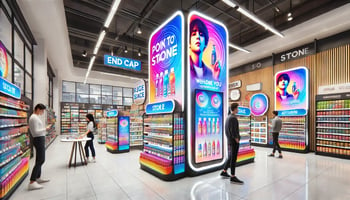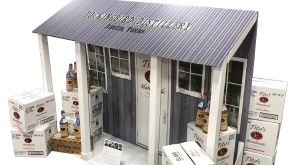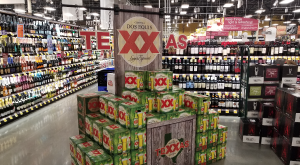Did you know that nearly 76% of purchase decisions are made in-store? This staggering statistic...
The Power of Retail Visual Merchandising: Tips, Techniques, and Trends
Visual merchandising plays a critical role in the success of retail businesses by attracting customers, enhancing their shopping experience, and encouraging purchases. In this blog, we’ll dive into the world of retail visual merchandising, exploring its principles, techniques, and trends. Whether you’re a small boutique or a large retail chain, mastering visual merchandising can transform your store and significantly impact your bottom line.
What is Retail Visual Merchandising?
Definition and History
Retail visual merchandising involves the strategic presentation of products in a way that enhances their appeal and encourages customers to make a purchase. It encompasses everything from window displays and in-store layouts to lighting, color schemes, and signage.
Visual merchandising has evolved significantly over the years. From simple product arrangements in early retail stores to the sophisticated, technology-driven displays we see today, visual merchandising has always been about creating an engaging and persuasive shopping environment. Some of these can include Case Riser Bins, Pole Toppers, and more variations.
Core Principles of Effective Visual Merchandising
The Five Senses
Effective visual merchandising engages all five senses to create a memorable shopping experience:
- Sight: The primary sense engaged through color, lighting, and display design.
- Sound: Background music can set the mood and influence shopping behavior.
- Smell: Pleasant scents can enhance the shopping experience and evoke emotions.
- Touch: Allowing customers to touch and feel products can increase perceived value.
- Taste: For food retailers, offering samples can directly influence purchasing decisions.
Color Theory
Color is a powerful tool in visual merchandising. Different colors evoke different emotions and can influence customer behavior:
- Warm Colors: Reds, yellows, and oranges create a sense of urgency and excitement.
- Cool Colors: Blues and greens have a calming effect and are often associated with trust and reliability.
- Neutral Colors: Blacks, whites, and grays can provide a sophisticated and modern look.
Lighting
Lighting is crucial in highlighting products and creating the right ambiance:
- Ambient Lighting: General lighting that provides overall illumination.
- Accent Lighting: Focused lighting used to highlight specific products or areas.
- Task Lighting: Practical lighting for specific tasks, such as fitting rooms or checkout areas.
Space and Layout
The layout of your store can significantly impact customer flow and shopping behavior:
- Grid Layout: Efficient and organized, often used in grocery stores.
- Free-Flow Layout: Encourages exploration and browsing, commonly seen in boutiques.
- Loop Layout: Guides customers through a predetermined path, maximizing exposure to products.
Techniques and Best Practices
Standee Displays
Standee displays are sometimes the first point of contact with potential customers and can make a lasting impression:
Example: A high-end fashion retailer used a dynamic standee display featuring life-sized models dressed in the latest collection. The standees were positioned strategically with dramatic lighting and engaging poses to catch the eye of passersby, resulting in increased foot traffic and sales.
Sports-Themed Displays
Themed displays can create a cohesive and immersive shopping experience:
Example: A beverage brand designed a sports-themed display using vibrant team colors, sports equipment, and branded merchandise. This theme was carried throughout the store, creating a seamless and engaging shopping experience that resonated with sports enthusiasts and boosted sales during major sporting events.
Shelf Bin Displays
Grouping products strategically can enhance cross-selling opportunities:
Example: A grocery store used shelf bin displays to group complementary products together, such as chips, salsa, and guacamole, creating a "snack time" display. This not only made shopping more convenient but also increased the average transaction value as customers were inspired to purchase multiple items for their snack needs.
Trends in Retail Visual Merchandising
Sustainability
Sustainable and eco-friendly visual merchandising is gaining traction as retailers recognize the importance of environmental responsibility. Using recycled materials for displays, incorporating natural elements like plants, and opting for energy-efficient lighting are becoming standard practices. These sustainable choices not only reduce the environmental footprint but also appeal to environmentally conscious customers, reinforcing the brand’s commitment to sustainability and attracting a growing segment of eco-aware shoppers.
Example: A major retailer used recycled materials for their displays and incorporated plants and greenery to create an eco-friendly shopping environment. This not only appealed to environmentally conscious customers but also reinforced the brand’s commitment to sustainability.
Technology Integration
Incorporating technology into visual merchandising can create highly interactive and engaging displays. Technologies like augmented reality (AR), virtual reality (VR), and digital screens enhance the shopping experience by providing dynamic and immersive interactions. These tech-driven displays can showcase product features, offer virtual try-ons, and even provide real-time reviews and recommendations. The integration of technology helps to attract tech-savvy customers, increase engagement, and drive higher conversion rates.
Example: A beauty retailer used augmented reality (AR) mirrors that allowed customers to try on makeup virtually. This innovative approach not only attracted tech-savvy shoppers but also increased product trials and sales.
Personalization
Personalized shopping experiences are becoming increasingly popular as retailers leverage data analytics to tailor their visual merchandising strategies. By understanding customer preferences and shopping behaviors, retailers can create customized displays and product recommendations that resonate on a personal level. Personalized visual merchandising makes customers feel valued and understood, leading to increased satisfaction and loyalty. This approach not only enhances the shopping experience but also significantly boosts the likelihood of purchase by aligning with individual customer needs and preferences.
Example: A fashion retailer used data analytics to create personalized product recommendations displayed on digital screens in-store. This tailored approach made customers feel valued and increased the likelihood of purchase.
Implementing Visual Merchandising in Your Store
Planning and Strategy
Developing a visual merchandising plan involves several key steps:
- Identify Goals: Determine what you want to achieve with your visual displays.
- Design and Produce: Create visually appealing designs that align with your brand.
- Placement: Strategically place displays in high-traffic areas.
- Monitor and Adjust: Track performance and make necessary adjustments.
Execution and Maintenance
Setting up and maintaining visual displays requires ongoing effort:
- Setup: Ensure displays are set up correctly and look as intended.
- Maintenance: Regularly update displays to keep them fresh and relevant.
Measuring Success
To measure the effectiveness of your visual merchandising efforts, focus on these key metrics:
- Sales Lift: Track the increase in sales of displayed products.
- Customer Engagement: Monitor how customers interact with the displays.
- Return on Investment (ROI): Calculate the financial return compared to the cost of the displays.
Retail visual merchandising is a powerful tool for driving sales and enhancing the shopping experience. By understanding its core principles, implementing effective techniques, and staying updated on the latest trends, you can transform your store and maximize its potential. Evaluate your current strategies and consider incorporating some of the examples and tips shared in this blog to elevate your retail game.
Design Your Perfect Beverage Display or Packaging with Kraftwork
Save time and money with our pre-engineered displays. Need something custom? Our creative team is ready for the challenge. We offer a streamlined process and unmatched beverage industry expertise.




